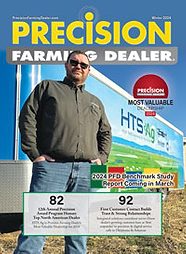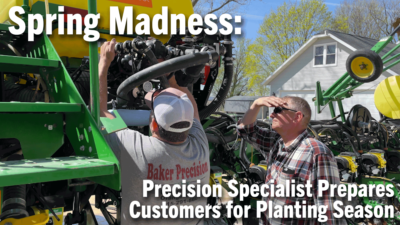By: Sue Neales
Source: The Australian
The tractor steers itself on Rob Ruwoldt's grain farm in Victoria's Mallee, down exactly the same designated "traffic" row between the canola and wheat crops in each paddock every time.
The massive sowing machines "know" how to drill seeds into the soil so accurately that Mr Ruwoldt can plant crops just 2cm from the previous year's remains, offering the young seedlings wind protection and the roots a primed nutrient- and worm-rich environment.
The headers, too, can tell automatically which of the paddocks on his 3000ha Murtoa farm they are harvesting at any moment of the day.
They then feed the crop yields obtained immediately back by wireless communication into Mr Ruwoldt's numerous farm computers, iPads and tractor-installed hard drives, where it is matched to infra-red soil and productivity maps of his entire farm.
"The technology is here to have tractors without drivers, operating themselves and turning right when they have to, while I sit in the office or on a phone somewhere," said the grain grower named Australian Farmer of the Year last year.
"But I don't think robot tractors are necessarily the way to go — I still think it's important to be out there doing it yourself, and getting some dirt under the nails. A robot can't really see how deep the seeds are going or how the moisture and worms are doing".
As one of the pioneers of the first no-tillage direct-drill farming in Australia in the 1980s, and now the automated Precision Farming techniques using hi-tech programmed farm machinery and global positioning system, Mr Ruwoldt is a self-confessed compulsive innovator.
It's a trait that makes him an automatic member of an exclusive club: the upper echelon of Australian producers dubbed this month at the annual conference of the Australian Bureau of Agricultural and Resource Economics and Sciences in Canberra as the new breed of "super farmers." These are the progressive farmers trying new technologies and innovations ahead of the pack and who are increasingly responsible for delivering the quest to double Australia's food production by 2050.
The ABARES conference heard how just 35 per cent of Australian grain growers are producing 80 per cent of the nation's 45 million tonne grain crop.
The latest ABARES productivity survey also revealed that the contribution of the bottom-performing 25 percent of farmers — all large sheep, wool, beef, dairy and crop producers — has shrunk to 9 per cent of farm production.
And the gap between the smartest and best farmers -- the so-called super farmers -- and others less willing or able to adopt cutting-edge new ways or technologies appears to be growing.
ABARES productivity manager Alistair Davidson said: "When we analysed farm-innovation behaviour, we found a very strong link between the high innovators and (increasing) productivity.
"We also found that farmers with a university education were 7 per cent more likely to be high innovators, and that for every 1 per cent increase in farm size, it was 4 per cent more likely the farmer was a high innovator."
Dr Davidson said that even the best innovators were improving their productivity and rate of technological change by only 0.7 per cent a year. For food output to be doubled by 2050, farm productivity needed to grow annually by 1.75 per cent.
"Many farmers could be doing better; that is why it is so important to discover what makes farmers innovative as that is the key to future increased productivity," Dr Davidson said.
Mr Ruwoldt, who returned to the family's Murtoa farm Glenvale after finishing school, doesn't think the secret to innovation is difficult to find. "I'm no better than anyone else; it's just that my passion is for growing crops and doing things a bit better and smarter each time," he said.
"But like in any industry, there are tiers and while some farmers would be better off giving the game away, the leading growers seriously need to be encouraged to stay in agriculture."
For that to happen, Mr Ruwoldt said farmers have to be paid more for their food and stop being squeezed by the multinationals.
He said no other self-respecting professional or worker would accept 1974 wages today, but wheat growers have had to endure that because this summer's price is down to $150 a tonne from $350 a tonne last year.
"What keeps you going in this job is doing well, trying new ways all the time, growing a good crop and then getting paid fairly for your work," he said.
"It's all very fine to tell us we have to be more productive and more sustainable, which is what my farming and focus on soil fertility and moisture is all about, but if even (top) growers like me can't afford to be here because we are not being paid enough for food, that's not very sustainable for Australia either."






Post a comment
Report Abusive Comment